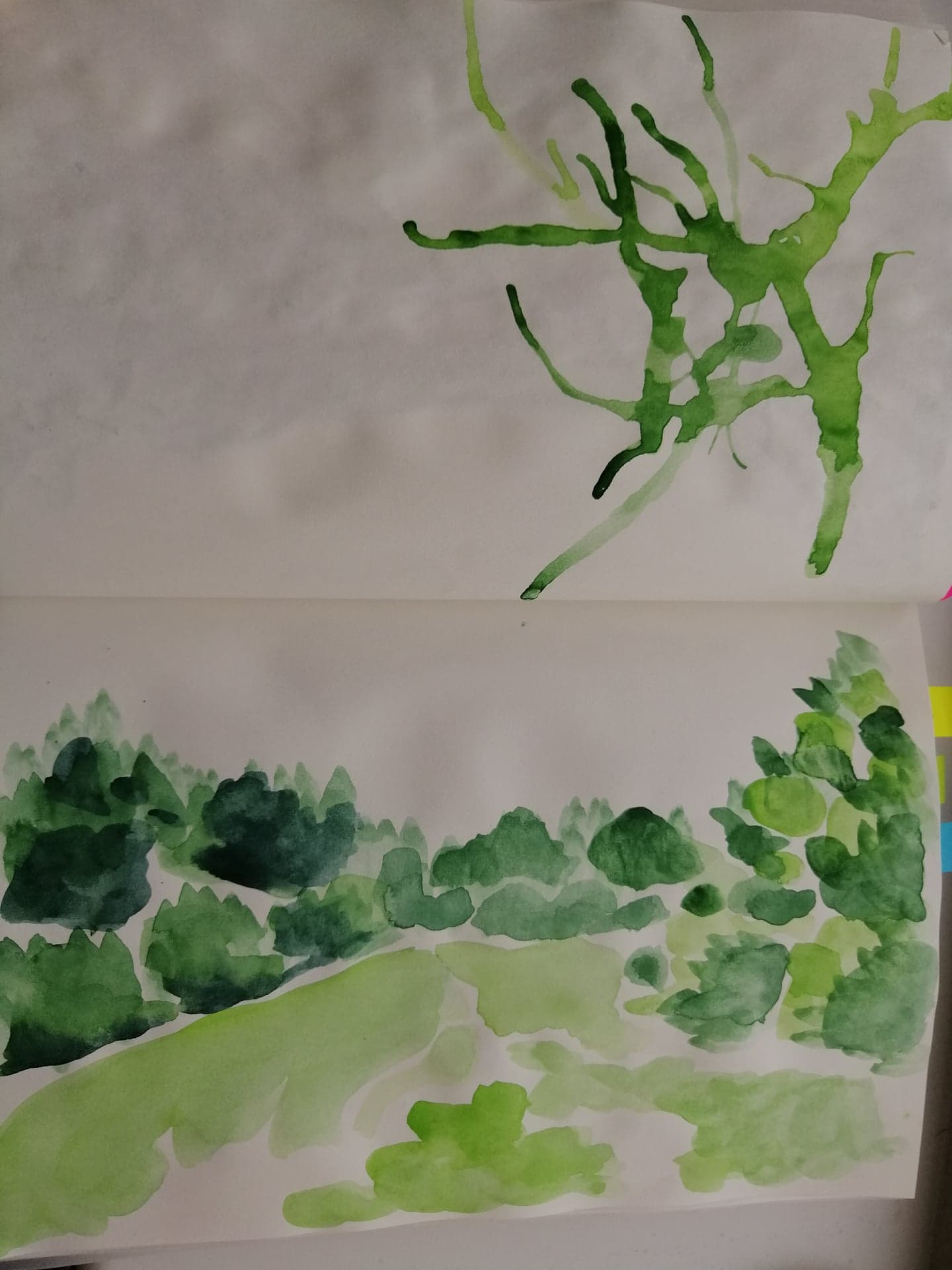Investigating a process
For all materials, I looked at a scene in front of me in the park (see photograph below [I took this photograph after some of my attempts – it remained mostly unchanged, though the sky altered over the time I was there]). Some studies took a few minutes, others were very quick. I tried not to spend too long on each and focused mainly on different ways of using the materials I had.

Watercolour
- Layering – I used to use watercolours much more than I do now, and I tended to layer colours and shapes to create richer, fuller colours and depth to an image. The top left image shows my quick attempt at this.
- Addition of water to paint – making the paint thicker/thinner (more translucent when thinned)
- Blobs that did not overlap or merge VS blending colours and shapes
- Lines over a wash – I tried one layer of pale/thin paint, then outlined the shapes of the trees with a thicker paint. The resulting effect focuses on the outlines of the shapes, rather than depth or tone, but I think the image is still readable.
- I tried to vary my mark-making, using different marks with a dry or wet paintbrush in my tests. When wet, the watercolour paints are easily manipulated across the page, leaving vein-like marks or blotchy patches, whereas when dry, the effect was more scratchy and sparse.
- Very watery consistency – blowing shapes with a straw (this produced a very pleasing effect, quite appropriate for tangled branches/leaves)
Pencil
- I started by testing the different hardness/softenesses of pencils and trialling a few marks. Pencil is probably the material I am most comfortable with, so it was important to me to experiment with patterns/mark-making (I usually go for time-consuming detailed shading)
- I tried keeping the pencil on the paper, to create a continuous line drawing of the scene.
- For one test, I used softer lead to do a ‘scribbly’ shaded depiction of the scene in front of me – it was much less refined than my usual style and didn’t take very long, but I liked the effect (cloudy, wild, nature).
- “scribbly” lines, swirls, cross-hatching, shading
- I also included some studies using coloured pencils – mostly using them to create shapes, shade, and layer.
Acrylic
- dry/wet – In contrast to watercolours, acrylics remain quite vivid when watered down. I liked the texture created with a dry brush; the paint is thicker and bolder, so it holds its shape and pattern and texture once applied.
- layers, textures – grass, leaves etc. – I started with black, then gradually layered up lighter shades of green leaves.
- In one of the studies, I used a bristly brush to create the effect of grass/flowers scattered across field by dabbing (the brush wasn’t loaded with too much paint).
- cotton wool and cotton bud – cotton wool had great stringy texture for grass (top right image, third). I dabbed the cotton wool in the paint (the paint was slightly sticky and thick, so it started to pull apart the cotton wool) and then dabbed or dragged it along the paper. The unpredictability of the material helped create that wild/natural look.
- cocktail stick – veins in leaves. Not a great tool for applying the paint, but good for manipulating the paint once on the paper.
- more focused depictions of individual leaves
- Tried a 3D forest/collection of trees to stick into sketchbook, using sponges to achieve the texture. Reminded me of children’s books with parts that jump out.
Ink
Biro and fine liner
- crosshatching – lines closer together darker, lines further apart lighter
- swirls – works best with biro, as this can be manipulated more to achieve different tones (different pressures)
- filling in line drawings with textures
- continuous line drawings – I liked these with the ink pen better, because the line is more defined. The pencil looks fuzzier and varies in tone, so the line seems less sure.
- I found I was scruffier with biro, and more controlled with ink pen and fine liner (possibly because the ink pen and fine liner seemed more permanent).






















